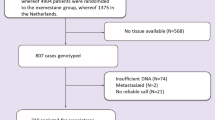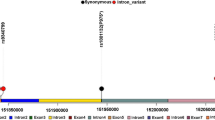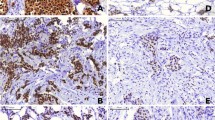Abstract
Estrogen receptor 1 (ESR1) and ESR2 gene polymorphisms have been associated with endocrine-mediated physiological mechanisms, and inconsistently with breast cancer risk and outcomes, bone mineral density changes, and hot flushes/night sweats. DNA was isolated and genotyped for six ESR1 and two ESR2 single-nucleotide polymorphisms (SNPs) from tumor specimens from 3691 postmenopausal women with hormone receptor-positive breast cancer enrolled in the BIG 1-98 trial to receive tamoxifen and/or letrozole for 5 years. Associations with recurrence and adverse events (AEs) were assessed using Cox proportional hazards models. 3401 samples were successfully genotyped for five SNPs. ESR1 rs9340799(XbaI) (T>C) variants CC or TC were associated with reduced breast cancer risk (HR = 0.82,95 % CI = 0.67–1.0), and ESR1 rs2077647 (T>C) variants CC or TC was associated with reduced distant recurrence risk (HR = 0.69, 95 % CI = 0.53–0.90), both regardless of the treatments. No differential treatment effects (letrozole vs. tamoxifen) were observed for the association of outcome with any of the SNPs. Letrozole-treated patients with rs2077647 (T>C) variants CC and TC had a reduced risk of bone AE (HR = 0.75, 95 % CI = 0.58–0.98, P interaction = 0.08), whereas patients with rs4986938 (G>A) genotype variants AA and AG had an increased risk of bone AE (HR = 1.37, 95 % CI = 1.01–1.84, P interaction = 0.07). We observed that (1) rare ESR1 homozygous polymorphisms were associated with lower recurrence, and (2) ESR1 and ESR2 SNPs were associated with bone AEs in letrozole-treated patients. Genes that are involved in estrogen signaling and synthesis have the potential to affect both breast cancer recurrence and side effects, suggesting that individual treatment strategies can incorporate not only oncogenic drivers but also SNPs related to estrogen activity.




Similar content being viewed by others
References
Sowers MR, Wilson AL, Karvonen-Gutierrez CA, Kardia SR (2006) Sex steroid hormone pathway genes and health-related measures in women of 4 races/ethnicities: the Study of Women’s Health Across the Nation (SWAN). Am J Med 119(9 Suppl 1):S103–S110. doi:10.1016/j.amjmed.2006.07.012
Almeida S, Hutz MH (2008) Estrogen receptor 1 gene polymorphisms in premenopausal women: interaction between genotype and smoking on lipid levels. Bra J Med Biol Res 41(10):872–876
Hayes DF, Skaar TC, Rae JM, Henry NL, Nguyen AT, Stearns V, Li L, Philips S, Desta Z, Flockhart DA, Consortium on Breast Cancer P (2010) Estrogen receptor genotypes, menopausal status, and the effects of tamoxifen on lipid levels: revised and updated results. Clin Pharmacol Ther 88(5):626–629. doi:10.1038/clpt.2010.143
Molvarec A, Nagy B, Kovacs M, Walentin S, Imreh E, Rigo J Jr, Szalay J, Fust G, Prohaszka Z, Karadi I (2007) Lipid, haemostatic and inflammatory variables in relation to the estrogen receptor alpha (ESR1) PvuII and XbaI gene polymorphisms. Clin Chim Acta 380(1–2):157–164. doi:10.1016/j.cca.2007.02.005
Ntukidem NI, Nguyen AT, Stearns V, Rehman M, Schott A, Skaar T, Jin Y, Blanche P, Li L, Lemler S, Hayden J, Krauss RM, Desta Z, Flockhart DA, Hayes DF, Consortium on Breast Cancer P (2008) Estrogen receptor genotypes, menopausal status, and the lipid effects of tamoxifen. Clin Pharmacol Ther 83(5):702–710. doi:10.1038/sj.clpt.6100343
Sowers MR, Symons JP, Jannausch ML, Chu J, Kardia SR (2006) Sex steroid hormone polymorphisms, high-density lipoprotein cholesterol, and apolipoprotein A-1 from the Study of Women’s Health Across the Nation (SWAN). Am J Med 119(9 Suppl 1):S61–S68. doi:10.1016/j.amjmed.2006.07.008
Crandall CJ, Sehl ME, Crawford SL, Gold EB, Habel LA, Butler LM, Sowers MR, Greendale GA, Sinsheimer JS (2009) Sex steroid metabolism polymorphisms and mammographic density in pre- and early perimenopausal women. Breast Cancer Res 11(4):R51. doi:10.1186/bcr2340
Onitilo AA, McCarty CA, Wilke RA, Glurich I, Engel JM, Flockhart DA, Nguyen A, Li L, Mi D, Skaar TC, Jin Y (2009) Estrogen receptor genotype is associated with risk of venous thromboembolism during tamoxifen therapy. Breast Cancer Res Treat 115(3):643–650. doi:10.1007/s10549-008-0264-2
Oger E, Lacut K, Mercier B, Le Gal G, Leroyer C, Pasquier E, Ferec C, Mottier D (2007) Estrogen receptor alpha polymorphism and venous thromboembolism in male and female: data from the EDITH study. Thromb Res 119(4):433–439. doi:10.1016/j.thromres.2006.05.002
Yaffe K, Lindquist K, Sen S, Cauley J, Ferrell R, Penninx B, Harris T, Li R, Cummings SR (2009) Estrogen receptor genotype and risk of cognitive impairment in elders: findings from the Health ABC study. Neurobiol Aging 30(4):607–614. doi:10.1016/j.neurobiolaging.2007.08.003
Boyapati SM, Shu XO, Ruan ZX, Cai Q, Smith JR, Wen W, Gao YT, Zheng W (2005) Polymorphisms in ER-alpha gene interact with estrogen receptor status in breast cancer survival. Clin Cancer Res 11(3):1093–1098
Dunning AM, Healey CS, Baynes C, Maia AT, Scollen S, Vega A, Rodriguez R, Barbosa-Morais NL, Ponder BA, Search, Low YL, Bingham S, Epic, Haiman CA, Le Marchand L, Mec, Broeks A, Schmidt MK, Abcs, Hopper J, Southey M, Abcfs, Beckmann MW, Fasching PA, Bbcc, Peto J, Johnson N, Bbcs, Bojesen SE, Nordestgaard B, Cgps, Milne RL, Benitez J, Cnio BCS, Hamann U, Ko Y, Genica, Schmutzler RK, Burwinkel B, Gc H, Schurmann P, Dork T, Habcs, Heikkinen T, Nevanlinna H, Hebcs, Lindblom A, Margolin S, Karbac, Mannermaa A, Kosma VM, Kbcs, Chen X, Spurdle A, kConFab, the AMG, Change-Claude J, Flesch-Janys D, Marie, Couch FJ, Olson JE, for M, Severi G, Baglietto L, Mccs, Borresen-Dale AL, Kristensen V, Nbcs, Hunter DJ, Hankinson SE, Nhs, Devilee P, Vreeswijk M, Origo, Lissowska J, Brinton L, Pbcs, Liu J, Hall P, Sasbac, Kang D, Yoo KY, Sebcs, Shen CY, Yu JC, Twbcs, Anton-Culver H, Ziogoas A, Ucibcs, Sigurdson A, Struewing J, Usrts, Easton DF, Garcia-Closas M, Humphreys MK, Morrison J, Pharoah PD, Pooley KA, Chenevix-Trench G, Bcac (2009) Association of ESR1 gene tagging SNPs with breast cancer risk. Hum Mol Genet 18 (6):1131–1139. doi:10.1093/hmg/ddn429
Gennari L, Merlotti D, De Paola V, Calabro A, Becherini L, Martini G, Nuti R (2005) Estrogen receptor gene polymorphisms and the genetics of osteoporosis: a HuGE review. Am J Epidemiol 161(4):307–320. doi:10.1093/aje/kwi055
Heilberg IP, Hernandez E, Alonzo E, Valera R, Ferreira LG, Gomes SA, Bellorin-Font E, Weisinger JR (2005) Estrogen receptor (ER) gene polymorphism may predict the bone mineral density response to raloxifene in postmenopausal women on chronic hemodialysis. Ren Fail 27(2):155–161
Henry NL, Nguyen A, Azzouz F, Li L, Robarge J, Philips S, Cao D, Skaar TC, Rae JM, Storniolo AM, Flockhart DA, Hayes DF, Stearns V (2010) Lack of association between oestrogen receptor polymorphisms and change in bone mineral density with tamoxifen therapy. Br J Cancer 102(2):294–300. doi:10.1038/sj.bjc.6605460
Li N, Dong J, Hu Z, Shen H, Dai M (2010) Potentially functional polymorphisms in ESR1 and breast cancer risk: a meta-analysis. Breast Cancer Res Treat 121(1):177–184. doi:10.1007/s10549-009-0532-9
Rapuri PB, Gallagher JC, Knezetic JA, Haynatzka V (2006) Estrogen receptor alpha gene polymorphisms are associated with changes in bone remodeling markers and treatment response to estrogen. Maturitas 53(4):371–379. doi:10.1016/j.maturitas.2005.07.007
Breast International Group 1-98 Collaborative G, Thurlimann B, Keshaviah A, Coates AS, Mouridsen H, Mauriac L, Forbes JF, Paridaens R, Castiglione-Gertsch M, Gelber RD, Rabaglio M, Smith I, Wardley A, Price KN, Goldhirsch A (2005) A comparison of letrozole and tamoxifen in postmenopausal women with early breast cancer. N Engl J Med 353(26):2747–2757. doi:10.1056/NEJMoa052258
Coates AS, Keshaviah A, Thurlimann B, Mouridsen H, Mauriac L, Forbes JF, Paridaens R, Castiglione-Gertsch M, Gelber RD, Colleoni M, Lang I, Del Mastro L, Smith I, Chirgwin J, Nogaret JM, Pienkowski T, Wardley A, Jakobsen EH, Price KN, Goldhirsch A (2007) Five years of letrozole compared with tamoxifen as initial adjuvant therapy for postmenopausal women with endocrine-responsive early breast cancer: update of study BIG 1-98. J clin Oncol 25(5):486–492. doi:10.1200/JCO.2006.08.8617
Colleoni M, Giobbie-Hurder A, Regan MM, Thurlimann B, Mouridsen H, Mauriac L, Forbes JF, Paridaens R, Lang I, Smith I, Chirgwin J, Pienkowski T, Wardley A, Price KN, Gelber RD, Coates AS, Goldhirsch A (2011) Analyses adjusting for selective crossover show improved overall survival with adjuvant letrozole compared with tamoxifen in the BIG 1-98 study. J clin Oncol 29(9):1117–1124. doi:10.1200/JCO.2010.31.6455
BIG 1-98 Collaborative Group, Mouridsen H, Giobbie-Hurder A, Goldhirsch A, Thurlimann B, Paridaens R, Smith I, Mauriac L, Forbes J, Price KN, Regan MM, Gelber RD, Coates AS (2009) Letrozole therapy alone or in sequence with tamoxifen in women with breast cancer. N Engl J Med 361(8):766–776. doi:10.1056/NEJMoa0810818
Giobbie-Hurder A, Price KN, Gelber RD (2009) Design, conduct, and analyses of Breast International Group (BIG) 1-98: A randomized, double-blind, phase-III study comparing letrozole and tamoxifen as adjuvant endocrine therapy for postmenopausal women with receptor-positive, early breast cancer. Clinical Trials 6(3):272–286. doi:10.1177/1740774509105380
Rae JM, Regan MM, Thibert JN, Gersch C, Thomas D, Leyland-Jones B, Viale G, Pusztai L, Hayes DF, Skaar T, Van Poznak C (2013) Concordance between CYP2D6 genotypes obtained from tumor-derived and germline DNA. J Natl Cancer Inst 105(17):1332–1334. doi:10.1093/jnci/djt204
McShane LM, Altman DG, Sauerbrei W, Taube SE, Gion M, Clark GM, Statistics Subcommittee of the NCIEWGoCD (2005) Reporting recommendations for tumor marker prognostic studies. J Clin Oncol 23(36):9067–9072. doi:10.1200/JCO.2004.01.0454
Regan MM, Leyland-Jones B, Bouzyk M, Pagani O, Tang W, Kammler R, Dell’orto P, Biasi MO, Thurlimann B, Lyng MB, Ditzel HJ, Neven P, Debled M, Maibach R, Price KN, Gelber RD, Coates AS, Goldhirsch A, Rae JM, Viale G, Breast International Group 1-98 Collaborative G (2012) CYP2D6 genotype and tamoxifen response in postmenopausal women with endocrine-responsive breast cancer: the breast international group 1-98 trial. J Natl Cancer Inst 104(6):441–451. doi:10.1093/jnci/djs125
Cai Q, Shu XO, Jin F, Dai Q, Wen W, Cheng JR, Gao YT, Zheng W (2003) Genetic polymorphisms in the estrogen receptor alpha gene and risk of breast cancer: results from the Shanghai Breast Cancer Study. Cancer Epidemiol Biomarkers Prev 12(9):853–859
Sakoda LC, Blackston CR, Doherty JA, Ray RM, Lin MG, Gao DL, Stalsberg H, Feng Z, Thomas DB, Chen C (2011) Selected estrogen receptor 1 and androgen receptor gene polymorphisms in relation to risk of breast cancer and fibrocystic breast conditions among Chinese women. Cancer Epidemiol 35(1):48–55. doi:10.1016/j.canep.2010.08.005
Shin A, Kang D, Nishio H, Lee MJ, Park SK, Kim SU, Noh DY, Choe KJ, Ahn SH, Hirvonen A, Kim JH, Yoo KY (2003) Estrogen receptor alpha gene polymorphisms and breast cancer risk. Breast Cancer Res Treat 80(1):127–131
Wang J, Higuchi R, Modugno F, Li J, Umblas N, Lee J, Lui LY, Ziv E, Tice JA, Cummings SR, Rhees B (2007) Estrogen receptor alpha haplotypes and breast cancer risk in older Caucasian women. Breast Cancer Res Treat 106(2):273–280. doi:10.1007/s10549-007-9497-8
Iwasaki M, Hamada GS, Nishimoto IN, Netto MM, Motola J Jr, Laginha FM, Kasuga Y, Yokoyama S, Onuma H, Nishimura H, Kusama R, Kobayashi M, Ishihara J, Yamamoto S, Hanaoka T, Tsugane S (2009) Isoflavone, polymorphisms in estrogen receptor genes and breast cancer risk in case-control studies in Japanese, Japanese Brazilians and non-Japanese Brazilians. Cancer Sci 100(5):927–933. doi:10.1111/j.1349-7006.2009.01118.x
Li LW, Xu L (2012) Menopausal status modifies breast cancer risk associated with ESR1 PvuII and XbaI polymorphisms in Asian women: a HuGE review and meta-analysis. Asian Pac J Cancer Prev 13(10):5105–5111
Maguire P, Margolin S, Skoglund J, Sun XF, Gustafsson JA, Borresen-Dale AL, Lindblom A (2005) Estrogen receptor beta (ESR2) polymorphisms in familial and sporadic breast cancer. Breast Cancer Res Treat 94(2):145–152. doi:10.1007/s10549-005-7697-7
Yu KD, Rao NY, Chen AX, Fan L, Yang C, Shao ZM (2011) A systematic review of the relationship between polymorphic sites in the estrogen receptor-beta (ESR2) gene and breast cancer risk. Breast Cancer Res Treat 126(1):37–45. doi:10.1007/s10549-010-0891-2
Henry NL, Giles JT, Ang D, Mohan M, Dadabhoy D, Robarge J, Hayden J, Lemler S, Shahverdi K, Powers P, Li L, Flockhart D, Stearns V, Hayes DF, Storniolo AM, Clauw DJ (2008) Prospective characterization of musculoskeletal symptoms in early stage breast cancer patients treated with aromatase inhibitors. Breast Cancer Res Treat 111(2):365–372. doi:10.1007/s10549-007-9774-6
Wang J, Lu K, Song Y, Xie L, Zhao S, Wang Y, Sun W, Liu L, Zhao H, Tang D, Ma W, Pan B, Xuan Q, Liu H, Zhang Q (2013) Indications of clinical and genetic predictors for aromatase inhibitors related musculoskeletal adverse events in Chinese Han women with breast cancer. PLoS ONE 8(7):e68798. doi:10.1371/journal.pone.0068798
Jin Y, Hayes DF, Li L, Robarge JD, Skaar TC, Philips S, Nguyen A, Schott A, Hayden J, Lemler S, Storniolo AM, Flockhart DA, Stearns V (2008) Estrogen receptor genotypes influence hot flash prevalence and composite score before and after tamoxifen therapy. J Clin Oncol 26(36):5849–5854. doi:10.1200/JCO.2008.16.8377
Ryan J, Canonico M, Carcaillon L, Carriere I, Scali J, Dartigues JF, Dufouil C, Ritchie K, Scarabin PY, Ancelin ML (2012) Hormone treatment, estrogen receptor polymorphisms and mortality: a prospective cohort study. PLoS ONE 7(3):e34112. doi:10.1371/journal.pone.0034112
Salmen T, Heikkinen AM, Mahonen A, Kroger H, Komulainen M, Saarikoski S, Honkanen R, Maenpaa PH (2000) Early postmenopausal bone loss is associated with PvuII estrogen receptor gene polymorphism in Finnish women: effect of hormone replacement therapy. J Bone Miner Res 15(2):315–321. doi:10.1359/jbmr.2000.15.2.315
Acknowledgments
We are indebted to the women, physicians, nurses, and data managers who participated in this clinical trial; to the many pathologists who submitted tumor blocks; to the BIG 1-98 Steering Committee; to Novartis for funding of the clinical trial and of the collection of tumor blocks; to the IBCSG for the design of the trial, coordination, data management, medical review, and statistical support; to the IBCSG Central Pathology Office for collection and processing of tumor blocks; to the BIG-198 Collaborative Group (members who submitted tumor blocks are listed in Supplementary Appendix, available online); and to Susan G. Komen for the Cure Promise Grant.
Funding
The BIG 1-98 trial sponsor, Novartis, contracted with the IBCSG to design the BIG 1-98 trial; collect, analyze, and interpret the data; and report the results. This report presents a study based on collected tumor material (collection partially funded by Novartis) and genotyping (funded by a Promise Grant from the Susan G. Komen for the Cure). The translational research, including DNA extraction and genotyping, was funded by Susan G. Komen for the Cure Promise Grant (KG080081 to GV, OP, MMR), the Breast Cancer Research Foundation (BCRF) (N003173 to JMR), and the National Institutes of Health (1RO1GM099143 to JMR). The Breast International Group (BIG) 1-98 trial was funded by Novartis and coordinated by the International Breast Cancer Study Group (IBCSG). Other support for the IBCSG: United States National Cancer Institute (CA75362 to MMR). The writing of this manuscript did not include representatives from Novartis or Susan G. Komen for the Cure. The BIG 1-98 Steering Committee reviewed the article, suggested changes, and is responsible for the decision to publish.
Author information
Authors and Affiliations
Consortia
Corresponding author
Ethics declarations
Conflicts of Interest
None of the authors have any conflict of interest.
Additional information
On behalf of the BIG 1-98 Collaborative Group. Members of the BIG 1-98 Collaborative Group who submitted tumor blocks are listed in Supplementary Appendix, available with the full text of this article at (journal website).
The BIG 1-98 trial registration ID: NCT00004205.
Electronic supplementary material
Below is the link to the electronic supplementary material.
Rights and permissions
About this article
Cite this article
Leyland-Jones, B., Gray, K.P., Abramovitz, M. et al. ESR1 and ESR2 polymorphisms in the BIG 1-98 trial comparing adjuvant letrozole versus tamoxifen or their sequence for early breast cancer. Breast Cancer Res Treat 154, 543–555 (2015). https://doi.org/10.1007/s10549-015-3634-6
Received:
Accepted:
Published:
Issue Date:
DOI: https://doi.org/10.1007/s10549-015-3634-6




